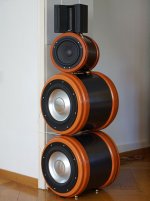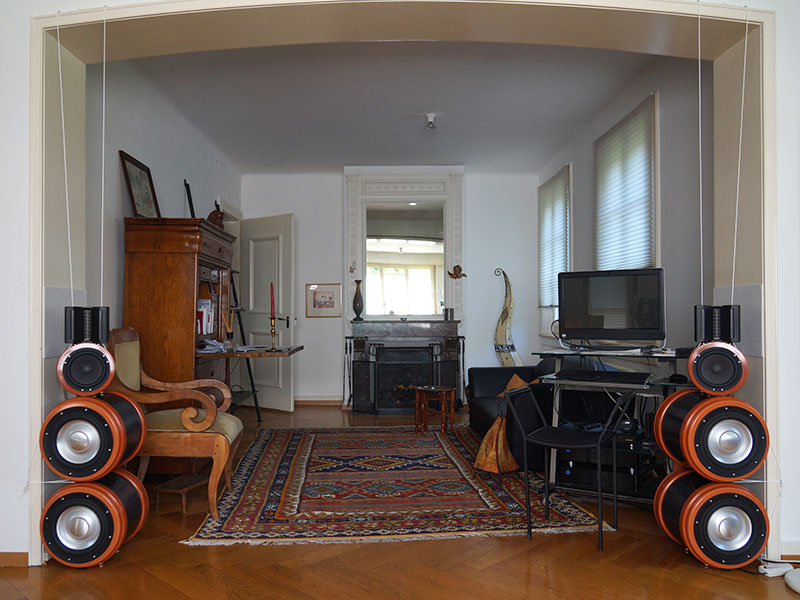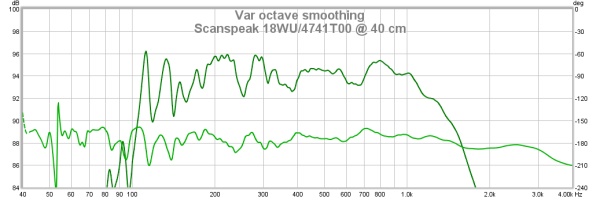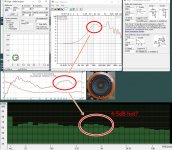After a previous build based on vertically stacked planar magnetic speakers, I decided to make a more or less conventional three-way loudspeaker system, keeping the dipole radiation for the highs only.

It has evolved into a linear-phase computer controlled system. Please follow this to see how:
JdM12 Audio Project 2016

It has evolved into a linear-phase computer controlled system. Please follow this to see how:
JdM12 Audio Project 2016
Thank you Erik, the bug is fixed. Best regards
Rob
So what I was going to ask is, and maybe I missed it, is there a chart for the combined FR and phase?
Best,
Erik
So what I was going to ask is, and maybe I missed it, is there a chart for the combined FR and phase?
Best,
Erik
I could not get informative in room measurements of the whole system because of huge variations depending on the mic position. That's why you see only close mic measurements of each driver.
Yeah, really tough to get accurate 1 m response on a tall multi-way in a typical room, though FWIW the mic is usually set at the tweeter's center-line since it's the most delayed.
GM
GM
I have the Heil AMT too and it is one of the best tweeters ever. Still looking for a worthy speaker build to be the crowning driver on. Nice build - I like the round "bongo drum" aesthetic. Although my recent experience with a circa 6in dia round baffle demonstrated to me what baffle diffraction can do to a normally flat mid range driver. I added 6dB to 10dB ripples due to the round baffle - the worst shape for speaker baffle. Did you not have a problem with this on the mid range sitting below the AMT?
20cm measurement distance will hide some of edge diffractions and baffle step, I believe that You can get quite reliable measurements at 1m distance and 7ms gating. For delay setting and crossover fine tuning 1.5-1.7m distance is even better.
Room positioning is near wall. The wall will give some loading of bass too. You should do listening-spot measurements with long gate or RTA, then do some global eq.

Room positioning is near wall. The wall will give some loading of bass too. You should do listening-spot measurements with long gate or RTA, then do some global eq.

Go at least 50cm to see baffle diffraction effects. This may be part of the reason why you see what you think are room effects (below 300Hz) anything ragged in response above 400Hz to 12kHz is most likely baffle diffraction. And I predict at least a 6dB peak/dip combo due to that round enclosure of same diameter as the midrange.
Look at SL's data on 6in dia round baffle here (10dB peak/dip at 3kHz):
http://www.linkwitzlab.com/diffraction.htm
Look at SL's data on 6in dia round baffle here (10dB peak/dip at 3kHz):
http://www.linkwitzlab.com/diffraction.htm
Last edited:
With my previous minimum phase setup, the real time spectrum analysis on pink noise at the listening position, 3.5m away from the speakers, filters applied, average of eight measures, looked like this:

The new filtering doesn't change it a lot.

The new filtering doesn't change it a lot.
Although my recent experience with a circa 6in dia round baffle demonstrated to me what baffle diffraction can do to a normally flat mid range driver. I added 6dB to 10dB ripples due to the round baffle - the worst shape for speaker baffle. Did you not have a problem with this on the mid range sitting below the AMT?
If my understanding is right, baffle diffraction increases with the size of the baffle. In this case, the baffle is just a little wider than the driver, so diffraction should be negligible, no matter the round shape.
About baffle step, it affects the region where radiation goes from omni-directional to forward firing (SL). As the midwoofer is used below the frequencies where it becomes directional, there is no need to boost the low frequencies.
But the enclosure's tubular shape is not the best regarding internal resonances. That's why it's better to keep it small.
The scale in RTA is small, but I see 4-5dB hotness in range of 400-1200hz, the baffle peak range in Edge simulation and in nearfield mesasurement too.
Easy to eq, I think you should try that!
Yes, and this peak is easily audible ('hollow' quality). I tried to equalize it, but not too much, to keep 'intelligibility'.
Last edited:
JdM12, have you ever considered checking the timing using APL_TDA software?
There's a growing thread started by the author of the software here: http://www.diyaudio.com/forums/full-range/284916-room-correction-speaker-correction-what-can-we-do-dsp-power-now-availabl.html
Sadly enough it got off track for a bit. There's also a spin off thread in this part of the forum: http://www.diyaudio.com/forums/multi-way/285628-apl-tda-acoustic-loudspeaker-analyzing-software.html
To me, running the demo was fun to see if my goal was indeed reached. It might help you get a clear picture what's happening in your room. The Demo won't save plots but you can look around. It will give you a sort of "time stamp" of first wave arrival.
It might take a bit of work to use your processing chain within the program but with my JRiver setup I managed to get it done.
There's a growing thread started by the author of the software here: http://www.diyaudio.com/forums/full-range/284916-room-correction-speaker-correction-what-can-we-do-dsp-power-now-availabl.html
Sadly enough it got off track for a bit. There's also a spin off thread in this part of the forum: http://www.diyaudio.com/forums/multi-way/285628-apl-tda-acoustic-loudspeaker-analyzing-software.html
To me, running the demo was fun to see if my goal was indeed reached. It might help you get a clear picture what's happening in your room. The Demo won't save plots but you can look around. It will give you a sort of "time stamp" of first wave arrival.
It might take a bit of work to use your processing chain within the program but with my JRiver setup I managed to get it done.
If my understanding is right, baffle diffraction increases with the size of the baffle. In this case, the baffle is just a little wider than the driver, so diffraction should be negligible, no matter the round shape.
About baffle step, it affects the region where radiation goes from omni-directional to forward firing (SL). As the midwoofer is used below the frequencies where it becomes directional, there is no need to boost the low frequencies.
But the enclosure's tubular shape is not the best regarding internal resonances. That's why it's better to keep it small.
1) No - the frequency range of BS decreases with baffle width. Round baffle is always worst scenario, because distance from the center of the radiator to edges is constant. With rectangular shape, distances get distributed and baffle step curve gets smoothed specially in upper end and above the null F. The Edge is wonderful simulator, you can easily test baffles and drivers size and location effects, also off-axis "beaming" Home of the Edge
2) Misunderstanding - just the opposite! Baffle step happens 2-4 octaves lower than beaming.
3) Yes, and the explanation is same as in issue 1) - constant distance to and between reflecting surfaces here. Irregular and non-parallel walls are best. This is why drum boxes and membranes are round - they give high boost of sound pressure at certain peak frequency, and also "ringing" ie. long decay of that frequency.
Last edited:
There's a growing thread started by the author of the software here: http://www.diyaudio.com/forums/full...on-what-can-we-do-dsp-power-now-availabl.html
Sadly enough it got off track for a bit. There's also a spin off thread in this part of the forum: http://www.diyaudio.com/forums/multi-way/285628-apl-tda-acoustic-loudspeaker-analyzing-software.html
Thanks for the very interesting references 🙂 I'll take time to go deeper into.
A graph for the midrange driver after filtering. 40 cm was the longest mic distance before phase rotation.


^looks like long 500ms IR gating (default) Obviously you have saved the measurement. Toggle IR button and change Right window to 4, 6, 8, 20 etc. ms, you will then see only first arrival! Low end is not precise, but you will see what happens with longer gating!
Toggle IR button and change Right window to 4, 6, 8, 20 etc. ms, you will then see only first arrival!
I see, very interesting, thank you!
- Status
- Not open for further replies.
- Home
- Loudspeakers
- Multi-Way
- 3-way loudspeaker system with Heil AMT tweeter

